Journal of Horticulture
Open Access
ISSN: 2376-0354
ISSN: 2376-0354
Research Article - (2023)Volume 10, Issue 1
The influence of Crop Load Management (CLM) on fruit quality, yield, and alternate bearing was assessed by comparing three methods of modifying the source: sink relationship: a) Mechanical, b) Chemical and c) Manual thinning. A total of 450 apple trees (Malus domestica Borkh., cv. ‘Roter Boskoop’; six years old) on M9 rootstock at the Klein-Altendorf field laboratory (50°N) of the university of Bonn, Germany were used. Trees were mechanically blossom-thinned at the balloon stage (BBCH 59) with a rotor speed of 320 rpm or 380 rpm at 5 km/h tractor speed or were chemically thinned at full bloom stage (BBCH 65) with Ammonium Thiosulfate (ATS), Ethephon (ETH), and/or 6-Benzyl Adenine (BA) at 10-12 mm fruit size (BBCH 71) after applying ATS/ETH. Flower clusters and/or cluster leaves were manually removed to determine the optimum sink-source ratio to achieve different ratios of fruitlets (sink) relative to the leaves (source) at fruit set (BBCH 67-69). Un-thinned, adjacent trees served as the control. The majority of CLM methods improved fruit quality in terms of fruit weight and size. Removing cluster leaves at fruit set increased fruit size and weight of the remaining fruit, which has not been observed before. The most effective treatment for fruit quality and return bloom improvement was the 75% flower cluster and complete cluster leaf removal. Removal of more than 50% of flower clusters successfully improved return bloom. The mechanical blossom thinning had a positive effect on fruit quality with a return bloom similar to that of removal of 50% flower clusters.
Apple (Malus domestica, cv. ‘Roter Boskoop’); Alternate bearing; Blossom thinning; Fruit
In fruit trees, a large number of fruits can result in slow fruit growth and small fruit size, and therefore a reduction in fruit load can be beneficial in fruit production to achieve optimum fruit quality. Crop Load Management (CLM) is an elegant strategy to improve fruit quality [1]. The two CLM methods commonly used in fruit cultivation are pruning and thinning. All CLM methods also aim to overcome alternate bearing [2], a major problem in pome and stone fruit as well as citrus cultivation worldwide, with severe fluctuations in yield from year to year [3]. Alternate bearing may be cultivar dependent and is influenced by a) biotic factors such as fruit load, carbohydrates and hormones associated with flowering, seed development, basipetal Gibberellic Acid (GA3) transport and b) abiotic environmental factors such as drought and spring frost [4,5].
Early thinning can moderate alternate bearing in many perennial fruit trees. Early hand thinning removes either flower buds (artificial spur extinction; ASE) or diseased or under-sized fruitlets in July, but it requires extensive manpower. Chemical thinners include Ammonium Thiosulfate (ATS), Ethephon (ETH), and Naphthalene Acetic Acid (NAA) that remove excess flowers or fruitlets or 6-benzyladenine (6-BA) for fruitlet thinning. The effect of chemical thinning is dependent upon weather conditions and cultivar. Approximately 7% of flowers are necessary in apple to achieve sufficient yield of high fruit quality. Mechanical blossom thinning is regarded as environmentally friendly and reduces the number of unwanted flowers [6-14].
At the time of flowering, carbohydrate reserves stored overwinter in bark and roots, as well as new carbohydrates formed in photosynthesis by cluster leaves, are the sources for flower and fruit growth. In addition, cluster leaves or spur leaves are the only source of current photosynthate for fruit (sink) growth until approximately 3 weeks after full bloom in apple. Removal of cluster leaves by hand is experimentally the most selective way to affect fruitlet development. Thus, this approach also decreases fruit set in flower clusters. Cluster leaf defoliation at petal fall did not inhibit return bloom, whereas the bourse shoot defoliation did. We hypothesized that cluster leaves play a critical role in fruit growth and fruit quality. Hence, we manipulated the source: sink relationship in order to determine the contribution of the cluster leaves and stored carbohydrates to fruit set, which has not been reported before to our knowledge [15-18].
Thus, this research investigated the influence of CLM by three different standard thinning methods and the effect of manual flower and cluster leaf removal on the number of fruitlets, fruit quality, and alternate bearing.
Trees treatment and location
Six-year-old apple trees cv. ‘Roter Boskoop’ on M9 rootstock were selected for the present study at the Klein-Altendorf field laboratory (50°N 6°E) of the university of Bonn, Germany. The 450, ca. 2.30 m tall, trees at a planting distance of 3.5 × 1 m had been trained as slender spindles and had produced a large blossom intensity of 8 in 2018 on the 1-9 scale of blossom intensity scale (1=no flowers to 9=white blossom) after the spring frost in April 2017. Treatments consisted of chemical or mechanical thinning and leaf or flower cluster removal by hand; the control was not treated (Table 1) [19].
Flower cluster and fruit counting as well as return bloom
Apple flower clusters on the trees were counted on 19th April 2018 at the balloon stage (BBCH 59) before CLM. Fruit set was calculated based on the number of fruit per 100 flower clusters before and after the June drop in 2018. Return bloom in the subsequent year was expressed using the blossom intensity scale on 10 detached branches (100%) per treatment subjected to a temperature of 20°C from December 2018 to February 2019 until flowering [20].
| Type of CLM | Treatment number/CLM description | Flower stage/fruit development |
|---|---|---|
| 1. Un-thinned control | U1: All flowers and cluster leaves remained | n.a. |
| 2. Cluster leaf removal | R1: 50% cluster leaf removal | Fruit set |
| R2: 100% cluster leaf removal | (BBCH 67-69) | |
| 3. CLM: Flower cluster and/or cluster leaf removal by hand | 25% flower cluster removal H1: Without cluster leaf removal H2: With 50% cluster leaf removal H3: With 100% cluster leaf removal |
Balloon-flowering (BBCH 59-61) for flower clusters removal Fruit set (BBCH 67-69) for cluster leaf removal |
| 50% flower cluster removal H4: Without cluster leaf removal H5: With 50% cluster leaf removal H6: with 100% cluster leaf removal |
||
| 75% flower cluster removal H7: Without cluster leaf removal H8: With 50% cluster leaf removal H9: With 100% cluster leaf removal |
||
| 4. Mechanical thinning | M1: 320 rpm rotor speed at tractor speed of 5 km/h M2: 380 rpm rotor speed at tractor speed of 5 km/h |
Balloon stage (BBCH 59) |
| 5. Chemical thinning | C1: ATS (15 L/ha)+ethephon (0.3 L/ha) C2: ATS (15 L/ha)+ethephon (0.3 L/ha) and BA (7.5 L/ha) |
Full bloom (BBCH 65) for ATS and Flordimex 420 Fruit size 10-12 mm (BBCH 71) for BA |
Table 1: Crop Load Management (CLM) in 2018.
Modification of source: Sink relationship in the flower cluster by flower cluster and cluster leaf removal by hand
Flower clusters and/or cluster leaves were removed to determine the optimum sink-source ratio to achieve different number of fruitlets (sink) relative to the number of leaves (source). At the beginning of flowering (BBCH 59-61), 25% (Treatment H1), 50% (Treatment H4), or 75% (Treatment H7) of flower clusters were removed manually. After full bloom (BBCH 67-69), 50% (Treatment H2, H5, and H8) of cluster leaves or 100% (Treatment H3, H6, and H9) of leaves in flower clusters were removed (Figure 1a and 1b), as can happen in hailstorms.
Figure 1: Source-sink modification by cluster leaf removal at fruit set: (a) 50% cluster leaves removed and (b) 100% cluster leaves removed (photos: ca. 2 months after treatment).
Mechanical thinning
The Bonner thinning device was used with three adjustable horizontal rotors mounted on the front of a tractor and was operated at a tractor speed of 5 km/h and rotor speeds of 320 rpm (Treatment M1) resulting in an integrated coefficient of thinning (ICT) of 3.8 (formula 1) or 380 rpm with an ICT of 6.3 at the balloon stage (BBCH 59) on 20th April 2018 (Table 1, Treatment M2). The ICT was developed to devise critical thresholds and aid future decision-making processes:

Where,
FS is the fruit set (%),
m is mass of a rope in the brush (3 g),
s is rotor speed (rpm),
r is radius (m), i.e., length of a rope in the brush (0.3 m) and
v is the vehicle speed or velocity (km/h).
Chemical thinning
ATS (15 L/ha application rate) was combined with ethephon (Flordimex 420, 420 g/L active ingredient, application rate of 0.3 L/ha) in a spray volume of 1000 L/ha for the first chemical thinning to remove blossoms at full bloom (BBCH 65) on 24th April 2018 at 10 am (15°C, 56% RH and 3 m/s wind speed) in treatment C1. At the onset of fruitlet development (BBCH 71), 6-benzyladenine (BA) (Exilis, 7.5 L/ha application rate) was also applied with an air-blast sprayer on 4th May 2018 when the air temperature was 19°C with 35% RH for the second chemical thinning to remove fruitlets in treatment C2.
Fruit quality and maturity assessment
One week before regular harvesting, ten apple fruits from all trees in each CLM treatment were examined for fruit quality and maturity using an ART system (UP Co., Osnabrück, Germany). The Streif index was calculated from fruit firmness measured by a penetrometer with a 10 mm2 plunger, Total Soluble Solids (TSS) concentration was measured using a digital refractometer (type PR 32; Atago Co., Tokyo, Japan) and starch breakdown after iodine-potassium staining was assessed on a 1-10 scale (no starch breakdown to complete starch breakdown). Remaining apple fruits were harvested on 22nd September 2018. Fruit size was averaged from apples of 10 trees per treatment by an automatic grading machine (type Greefa MSE 2000; Geldermalsen, Holland).
Experimental design and statistical analysis
The manual CLM treatments H1-H9 were on individual trees, whereas both the mechanical (Treatment M1 and M2) and chemical treatments (Treamtnet C1 and C2) were on 10 adjacent trees in a row, separated by a border tree. Two rows contained ten untreated trees, which served as un-thinned control. The fruit set, as the number of remaining apple fruit before and after June drop and fruit quality, was statistically evaluated using SPSS version 24 (SPSS Co., USA). Levene’s test was applied for the examination of the homogeneity of variances. The Dunnett-T3 test determined the difference between group means and the un-thinned control at the 95% confidence level, whereas LSDs indicate the difference between group means in case of homogeneous variances.
Effect of CLM on fruit set before and after June drop
The fruit set and/or thinning efficiency as number of apple fruitlets before June drop expressed per 100 flower clusters (=100%) is presented for the mechanical, chemical and manual thinning in Figure 2, whereas Figure 3 presents the underlying regulatory mechanisms and source-sink modification by cluster leaf removal.
The efficiency of CLM in terms of fruit set reduction was successful when 50% or 75% flower clusters were removed compared with the un-thinned control, resulting in a 56% and 46% reduction. The faster rotor speed of mechanical thinning of 380 rpm with the ICT of 6.2 (Treatment M2) removed more flowers and thinned more effectively than the slower rotation speed of 320 rpm with the ICT of 3.6 (Treatment M1) (46.5% and 56.5%, respectively). Both rotor speeds were as or were more efficient than the two chemical treatments of ATS/ETH at full bloom (BBCH 65) (Treatment C1) and ATS/ETH/BA at a fruit size 10 mm-12 mm (BBCH 71) (Treatment C2) (65.6% and 60%, respectively), based on the number of fruitlets per 100 flower cluster before June drop (Figure 2).
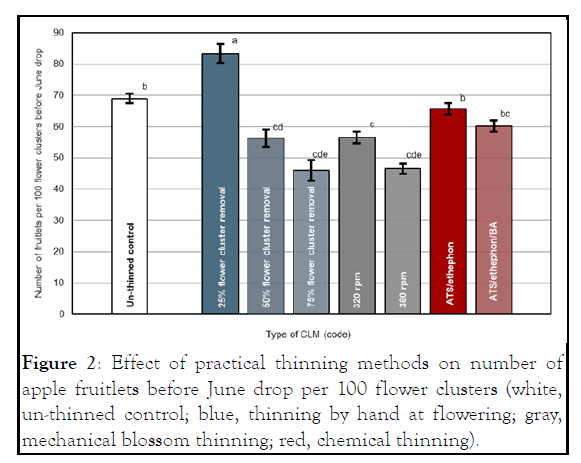
Figure 2: Effect of practical thinning methods on number of apple fruitlets before June drop per 100 flower clusters (white, un-thinned control; blue, thinning by hand at flowering; gray, mechanical blossom thinning; red, chemical thinning).
Fruit set was successfully decreased if more than 50% of cluster leaves were removed (Figure 3). The loss of 100% photosynthesizing cluster leaf area (Treatment R2) induced a significantly stronger flower/fruitlet drop than that of 50% cluster leaf removal (Treatment R1) (54% and 77%, respectively) (Table 2). Only two treatments (R1 and H1), the un-thinned flower cluster with 50% cluster leaf removal and 25% flower cluster removal with all cluster leaves remaining, had a larger fruit set (77.3% and 83.3%, respectively) than that of the unthinned control.
The trees compensated for excessive fruitlet removal by reducing their June drop. Consequently, the number of fruitlets per 100 flower clusters significantly declined in the strong CLM treatments (Figure 4). Chemical thinning using ATS/ETH (Treatment C1) and ATS/ETH/BA (Treatment C2) had a negligible effect (56% and 50%, respectively) on either June drop or total fruit drop in comparison with the un-thinned control trees (Treatment U1). Two CLM treatments, hand removal of 50% (Treatment H4) and 75% flower clusters (Treatment H7), resulted in the intended reduction of fruitlets per 100 flower clusters (45.5% and 38%, respectively) (Table 2). Similarly, both rotor speeds of the mechanical thinning device were successful in reducing fruit set with 39% (Treatment M2) and 47% (Treatment M1), respectively (Figure 5).
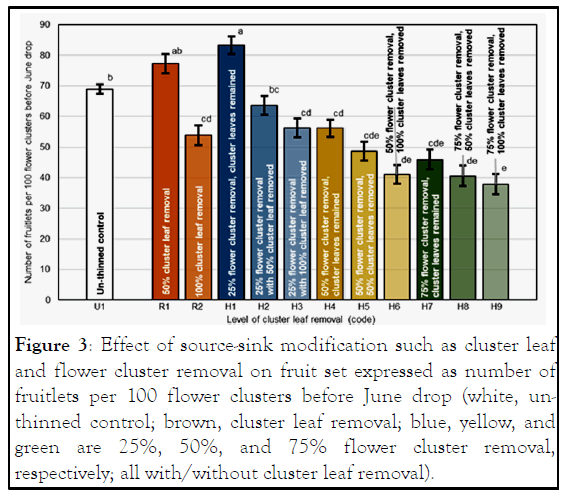
Figure 3: Effect of source-sink modification such as cluster leaf and flower cluster removal on fruit set expressed as number of fruitlets per 100 flower clusters before June drop (white, unthinned control; brown, cluster leaf removal; blue, yellow, and green are 25%, 50%, and 75% flower cluster removal, respectively; all with/without cluster leaf removal).
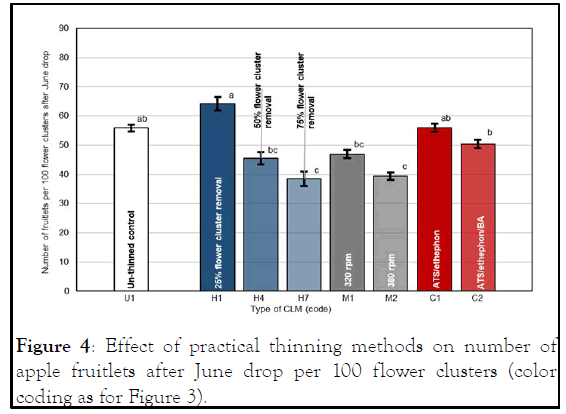
Figure 4: Effect of practical thinning methods on number of apple fruitlets after June drop per 100 flower clusters (color coding as for Figure 3).
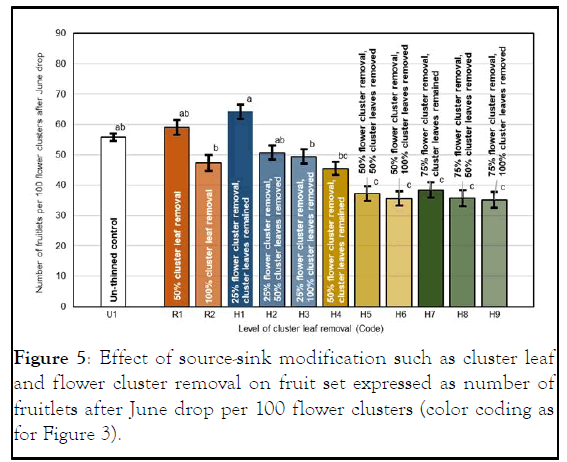
Figure 5: Effect of source-sink modification such as cluster leaf and flower cluster removal on fruit set expressed as number of fruitlets after June drop per 100 flower clusters (color coding as for Figure 3).
There was a similar trend in the number of fruitlets per 100 flower clusters after June drop from all treatments with flower and/or cluster leaf removal by hand (Figure 5) with the number of fruits before June drop (Figure 4). Removal of cluster leaves succeeded in reducing fruit set both before (Treatment H3-H9; Figure 4) and after June drop (Treatment H5-H9; Figure 6). Loss of 100% photosynthesizing cluster leaf area (Treatment R2) induced less fruit set than that induced by 50% cluster leaf removal (Treatment R1) (47% and 59%, respectively) (Figure 5). The combined 75% flower cluster and complete cluster leaf removal (Treatment H9) achieved the significantly smallest fruit set after June drop (35%) compared with the un-thinned control (Treatment U1) (Table 2).
| Treatment code | Type of CLM | Number of fruitlets per 100 flower clusters before June drop | Number of fruitlets per 100 flower clusters after June drop | Reduction in June drop*(%) |
|---|---|---|---|---|
| U1 | Un-thinned control | 68.9b | 55.8ab | 19ab |
| Cluster leaf thinning | ||||
| R1 | 50% cluster leaf removal | 77.3ab | 59ab | 23.8a |
| R2 | 100% cluster leaf removal | 53.9cd | 47.3b | 12.2bc |
| CLM by hand | ||||
| 25% flower clusters removed | ||||
| H1 | Without cluster leaf removal | 83.3a | 64.2a | 22ab |
| H2 | With 50% cluster leaf removal | 63.6bc | 50.7ab | 19.8ab |
| H3 | With 100% cluster leaf removal | 56.2cd | 49.4b | 11.5bc |
| 50% flower clusters removed | ||||
| H4 | Without cluster leaf removal | 56.2cd | 45.5bc | 17abc |
| H5 | With 50% cluster leaf removal | 48.7cde | 37.2c | 22.8ab |
| H6 | With 100% cluster leaf removal | 41.1de | 35.6c | 11.2bc |
| 75% flower clusters removed | ||||
| H7 | Without cluster leaf removal | 46cde | 38.4c | 15.6abc |
| H8 | With 50% cluster leaf removal | 40.6de | 35.8c | 10bc |
| H9 | With 100% cluster leaf removal | 37.9e | 35.2c | 7c |
| Mechanical blossom thinning | ||||
| M1 | 320 rpm | 56.5c | 46.9bc | 16abc |
| M2 | 380 rpm | 46.5cde | 39.4c | 15bc |
| Chemical thinning | ||||
| C1 | ATS/ethephon | 65.6b | 55.9ab | 14bc |
| C2 | ATS/ethephon/BA | 60.2bc | 50.4ab | 15bc |
a, b, c, d and e Significant difference according to Dunnett-T3 and LSD with P>0.05
*Percentages refer to the number of fruit per tree before June drop (100%)
Table 2: Effect of Crop Load Management (CLM) on number of fruitlets before and after June drop and fruit reduction in June drop.
CLM affects June drop
The intensity of the natural June drop was reduced to different extents by CLM at flowering. Following severe flower cluster removal there was a small June drop in contrast to a stronger June drop after slight flower cluster removal (Figure 6).
The 75% flower cluster and all cluster leaf removal (Treatment H9) was the strongest manipulation with a close source: sink relationship and induced the smallest June drop reduction (7%, with 93% of fruit remaining). This CLM had the smallest number of fruitlets before (Figure 3) and after June drop (Figure 5). However, all treatments with a wide source: sink relationship produced a large June drop, such as 50% cluster leaf re-moval (Treatment R1), 50% flower cluster and 50% cluster leaf removal (Treatment H5), and 25% flower cluster removal with remaining cluster leaves (Treatment H1) (24%, 23%, and 22%, respectively) in comparison with that of the un-thinned control (Treatment U1) (19%). All four treatments of 100% cluster leaf removal (Treatment R2, H3, H6, and H9) successfully reduced fruit set before and after June drop (Figure 7).
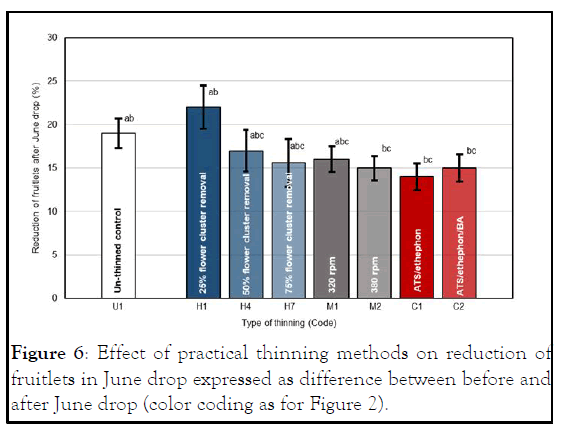
Figure 6: Effect of practical thinning methods on reduction of fruitlets in June drop expressed as difference between before and after June drop (color coding as for Figure 2).
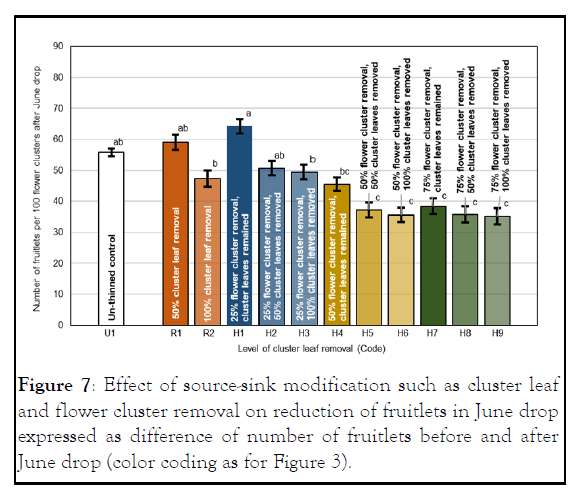
Figure 7: Effect of source-sink modification such as cluster leaf and flower cluster removal on reduction of fruitlets in June drop expressed as difference of number of fruitlets before and after June drop (color coding as for Figure 3).
Effect of CLM on fruit quality and yield
Except for starch, the internal quality of apple cv. ‘Roter Boskoop’ in all treatments was within or exceeded the recommended range at fruit harvest with a fruit firmness of 8-9 kg/cm2, sugar content of 11.5-12.5o Brix, starch breakdown of 4-6, and Streif index of 0.08-0.15 (Table 3). All CLM treatments were significantly more effective in improving fruit weight compared with results from the un-thinned control (Table 4), and there was no major reduction in yield in most cases except for cluster leaf removal. The largest fruit were achieved with the most severe CLM in the close source: sink relationship with the 75% flower cluster with cluster leaf removal (Treatment H7-H9). This treatment H9 had the greatest percentage (86%) of fruit >80 mm diameter and the largest weight of 318 g/fruit, although this treatment also had the smallest yield of 14.4 kg/tree (Table 4). All CLM trees had more than 65% of fruit with a diameter of >80 mm and a weight heavier than 239 g/fruit. This is in contrast to results from the wide source: sink relationship in the un-thinned control trees (Treatment U1) (57% of fruit diameter >80 mm, fruit weight of 228 g/fruit and yield of 21.1 kg/tree), which produced a large fruit yield but with the smallest fruit.
| Treatment code | Type of CLM | Firmness (kg/cm2) | Sugar (oBrix) | Starch breakdown (1-10) | Streif index | Blossom intensity (scale 1-9)b in 2019 |
|---|---|---|---|---|---|---|
| U1 | Un-thinned control | 8.6 | 15.1 | 3 | 0.19 | 2 |
| Cluster leaf thinning | ||||||
| R1 | 50% cluster leaf removal | 8.8 | 15.8 | 2.9 | 0.2 | 2 |
| R2 | 100% cluster leaf removal | 8.6 | 16* | 2.8 | 0.21 | 2 |
| CLM by hand | ||||||
| 25% flower clusters removed | ||||||
| H1 | without cluster leaf removal | 9 | 14.9 | 2.6 | 0.24 | 2 |
| H2 | with 50% cluster leaf removal | 8.7 | 15.1 | 3.2 | 0.19 | 2 |
| H3 | with 100% cluster leaf removal | 9.1 | 15.5 | 2.7 | 0.23 | 2 |
| 50% flower clusters removed | ||||||
| H4 | without cluster leaf removal | 8.9 | 15.9* | 2.9 | 0.2 | 3* |
| H5 | with 50% cluster leaf removal | 8.9 | 15.4 | 3.6 | 0.19 | 3* |
| H6 | with 100% cluster leaf removal | 9.3 | 16* | 2.8 | 0.22 | 4* |
| 75% flower clusters removed | ||||||
| H7 | without cluster leaf removal | 8.9 | 15.9* | 3.7 | 0.18 | 4* |
| H8 | with 50% cluster leaf removal | 9.2 | 16* | 2.7 | 0.22 | 4* |
| H9 | with 100% cluster leaf removal | 9 | 16.7* | 3.2 | 0.19 | 4* |
| Mechanical blossom thinning | ||||||
| M1 | 320 rpm | 9 | 15.6 | 2.7 | 0.23 | 3* |
| M2 | 380 rpm | 9 | 15.8 | 2.8 | 0.22 | 2 |
| Chemical thinning | ||||||
| C1 | ATS/ethephon | 8.8 | 15.4 | 2.7 | 0.22 | 2 |
| C2 | ATS/ethephon/BA | 8.8 | 15.5 | 3.2 | 0.19 | 2 |
*Significant difference according LSD and P>0.05 in comparison with un-thinned control
b 1=no flowers to 9=white blossom
Table 3: Effect of thinning treatment on the internal quality of apple cv. ‘Roter Boskoop’ in 2018 and blossom intensity in 2019.
Chemical thinning with ATS and ethephon with/without BA (Treatment C1 and C2) improved fruit size and weight with 80%-82% of fruit with a diameter of >80 mm and a weight of 262 g/fruit-277 g/fruit but did not reduce the fruit yield of 22 kg/tree-23 kg/tree in comparison with results from the un-thinned control (Table 4).
| Treatment code | Type of CLM | Fruit weight (g/fruit) | Percentage of fruit size >80 mm diameter (%) | Yield (kg/tree) |
|---|---|---|---|---|
| U1 | Un-thinned control | 228.3 | 56.8 | 21.1 |
| Cluster leaf thinning | ||||
| R1 | 50% cluster leaf removal | 259.2 | 77.3* | 24.4 |
| R2 | 100% cluster leaf removal | 238.9 | 65.1* | 18.6 |
| CLM by hand | ||||
| 25% flower clusters removed | ||||
| H1 | without cluster leaf removal | 253.2 | 72.7* | 21.3 |
| H2 | with 50% cluster leaf removal | 259.5 | 74.5* | 19 |
| H3 | with 100% cluster leaf removal | 277.9* | 85.7* | 18* |
| 50% flower clusters removed | ||||
| H4 | without cluster leaf removal | 259.6 | 76.2* | 18.2 |
| H5 | with 50% cluster leaf removal | 266.3 | 78.1* | 18* |
| H6 | with 100% cluster leaf removal | 276* | 80.9* | 15.3* |
| 75% flower clusters removed | ||||
| H7 | without cluster leaf removal | 293.6* | 81.6* | 14.7* |
| H8 | with 50% cluster leaf removal | 302.5* | 82.6* | 15.1* |
| H9 | with 100% cluster leaf removal | 318.2* | 86.4* | 14.4* |
| Mechanical blossom thinning | ||||
| M1 | 320 rpm | 280.2* | 81.4* | 15.9* |
| M2 | 380 rpm | 256.9* | 73.5* | 18.5 |
| Chemical thinning | ||||
| C1 | ATS/ethephon | 262.3 | 79.9* | 22.9 |
| C2 | ATS/ethephon/BA | 277* | 82* | 22.3 |
*Significant difference according Dunnett-T3 and P>0.05 in comparison with un-thinned control
Table 4: Effect of thinning treatment on fruit weight, fruit size distribution expressed as percentage of total yield and yield per tree, cv. ‘Roter Boskoop’ in 2018.
Effect of CLM on return bloom
Apple trees benefited from CLM in 2018 in terms of improved or similar return bloom and less alternate bearing in 2019. The greatest return bloom (score 4) appeared after the most severe CLM treatment, which was the 75% flower cluster removal irrespective of cluster leaf removal (Treatment H7, H8, and H9), whereas 50% (Treatment H4) and 25% (Treatment H1) flower cluster thinning scored only 3 and 2 (Table 3). Partial cluster leaf removal (Treatment R1 and R2) did not affect return bloom with a score of 2 similar to that of the un-thinned control (Treatment U1). The weaker mechanical blossom thinning (Treatment M1) (320 rpm) scored 3, whereas the stronger mechanical thinning (Treatment M2) (380 rpm) scored 2. The two chemical blossom thinning treatment using ATS/ETH with/without additional BA at 10 mm-12 mm fruit size (Treatment C1 and C2) scored 2, similar to the un-thinned control.
This study was carried out in 2018 following a frost in April 2017 all over Europe with 80% loss of flowers and fruitlets. As a consequence, apple trees showed a strong flowering in April 2018. The heavy June drop and weak fruit set resulted from the hot and dry spring and summer 2018 throughout Europe. Our objective was to study the effect of flower reduction by three methods of CLM. Thus, hand, mechanical, and chemical thinning were applied to study the regulation of fruit set, June drop, return bloom, fruit quality, and yield and to determine the optimum source: sink relationship.
Efficacy of mechanical thinning and ICT
The results from more effective mechanical thinning at the faster rotor speed (Figure 3) in terms of removing excess flowers are in line with those of Hehnen, et al. And Solomakhin and Blanke. In their experiments, faster rotor speeds of 360 rpm in the US and 420 rpm in Europe removed excess apple flowers more effectively than the weak-er rotor speeds of 260 rpm and 300 rpm. These authors invented ICT, taking into account the larger impact of increasing rotor speed and inverse relationship to tractor speed and fruit set. The optimum ICT of 10-40 was found for a tractor speed range of 5 km/h or 7.5 km/h. Hehnen, et al. reported on a lower ICT between 4-10 at a tractor speed of 2.5 km/h in Washington State, USA without considering the number of fruit removed per cluster in formula 1. The ICT of 6.2 in the stronger mechanical thinning at a 380 rpm rotor speed from our experiment was similar to that of Solomakhin and Blanke (ICT of 6.1) at a rotor speed of 420 rpm and 5 km/h tractor speed. Kong, et al. used the same machine at a rotor speed of 420 rpm and 5 km/h tractor speed to produce ICTs of 6.0 and 6.4.
Efficacy of chemical thinning
The application of chemical treatments ATS and ethephon at full bloom (BBCH 65) and BA at 10 mm-12 mm fruit size (BBCH 71) occurred after a strong spring frost in 2017, and consequently there was a heavy bloom in 2018. There were no significant differences in the number of fruitlets per 100 flower clusters before (fruit set) and after June drop between chemical thinning in comparison with those in the un-thinned control (Table 2). The negligible effect of chemical thinning in this experiment was caused by unfavorable weather condition during and after BA application and flower development that caused unpredictable fruit set responses and poor fruit set reduction. During BA application, the temperature was 19°C and dropped to 12°C in the subsequent days in contrast to the optimum temperature of 20°C-25°C.
ATS was applied for blossom thinning at full bloom (BBCH 65) at the optimum stage when most flowers opened. Our result is consistent with the model of Frank Maas where ATS inhibits pollen tube growth and hence does not affect already pollinated flowers; the efficacy of ATS was decreased by 50% when ATS was applied approximately 32 h after pollination.
Ethephon was applied to reduce excessive flowering in conjunction with ATS at full bloom stage at a temperature of ca. 15°C. This is below the optimum temperature of 18°C-22°C for the ethephon application. Thus, ethephon did not appear to reduce excessive flowers and inhibit fruit set in this experiment.
Efficacy of source-sink modification by flower cluster and cluster leaf removal by hand
In our study, merely 25% flower cluster removal did not decrease the number of fruitlets before June drop. However, 75% flower cluster removal with a leaf: fruit ratio of 29:1 resulted in the least number of fruits before and after June drop (Table 2). This is close to the optimum source: sink relationship when all clusters leaves remained on the tree in comparison with 25% (17:1) and 50% (21:1) flower cluster removal and unthinned control (18:1). Our result agrees with that of Blanke where CLM and a smaller fruit number reduce competition between sinks in the partitioning for photo assimilates. In addition, removing 75% flower clusters in this experiment provided a source: sink relationship close to the optimal leaf: fruit ratio of between 20-30:1 and 40-50:1 or 25-30 apple leaves supporting a 160 g fruit with photo-assimilates.
Breen, et al. suggested that the final fruit number under frostfree weather conditions in the apple growing region of New Zealand can be determined by Artificial Spur Extinction (ASE) between dormancy and early bud break (BBCH 51-52) and flower cluster thinning at pink bud stage (BBCH 57). Both methods improve the fruit set, which is in line with our manual removal of flower clusters (BBCH 59-61) (data not shown). In both cases, removal and uniform spatial distribution of buds provided a positive effect in an irradiance of fruiting spurs and increased the photosynthate availability to developing fruit. ASE as an early thinning method with a positive effect on fruit quality and alternate bearing might not be appropriate in areas such as Canada and Bonn, where spring frost reduces the number of floral buds, flowers or fruitlets. Crop load regulation should include the possibility of a spring frost for a consistent fruit yield.
With an untwined flower cluster and 50% cluster leaves removed (Treatment R1), sufficient carbon and energy sources from cluster leaves and stored carbohydrates remained available to maintain flowers and fruitlets on the tree. Fruit abscission was only achieved, when all cluster leaves (Treatment R2) were removed, which was not observed before. This suggests that the remaining 50% cluster leaves may increase photosynthesis and that primary leaves next to flowers or cluster leaves near young fruits were the main sources of carbohydrates for the young fruit growth during 3-5 weeks after bloom.
Effect of CLM on June drop and return bloom
Apple trees are susceptible to fruit abscission and CLM within three main periods: a) When unfertilized flowers are discarded by the trees 1 and 4 weeks after full bloom: b) 5-6 weeks after full bloom with June drop of fruitlets, which have developed fewer seeds because of insufficient fertilization; and c) ca. 4 weeks before harvesting, called pre-harvest fruit drop. All three fruit falls have a negative effect, because they decrease fruit yield.
The majority of CLM by blossom thinning, which decreased fruit set and altered source: sink relationship, positively affected the June drop in comparison with that of the un-thinned control (Table 2). Both, mechanical blossom thinning at 320 rpm (Figure 6) and cluster leaf removal reduced June drop (Figure 8), except for 50% cluster leaf removal. In this experiment, the smallest June drop appeared after the most severe CLM treatment with 75% flower cluster and all cluster leaf removal (7%) (Figure 7).
The apple cv. ‘Roter Boskoop’, selected for this experiment, is susceptible to alternate bearing. Consequently, there was a low flowering intensity in 2019 (Table 3, score value 2) after the high flowering intensity in 2018 (maximum score value 8) in the unthinned control. However, the effect of alternate bearing was partly mitigated by CLM in this experiment, and fewer blossom buds developed compared with those in normal years because of the hot summer and autumn in 2018. Removal of more than 50% of flower clusters improved the return bloom similar to that seen with the weaker mechanical thinning (Table 3). Embree, et al. and Meland supported the idea that crop load reduction enhances flower formation, whereas higher crop loads result in lower return bloom.
Our result is consistent with the findings of Elsysy and Hirst, where cluster leaf or spur leaf removal did not improve flower formation for next year. Cluster leaf removal in our experiment provided a positive effect on return bloom improvement when it was applied after 50% or 75% flower cluster removing. In addition, all cluster leaf removal successfully reduced fruit set (Table 2) and improved the fruit quality (Table 3).
Effect of CLM on fruit quality and fruit yield
All CLM methods maintained good fruit quality in terms of firmness, level of sugar, starch breakdown, and ripeness (Table 3). Moreover, all CLM trials in our experiments significantly enhanced the fruit weight in comparison with that in the unthinned control (229 g/fruit) (Table 4). The percentage of fruit larger than 80 mm was greater in all CLM treatments than that in the un-thinned control (57%). This result is consistent with the findings from Hehnen, et al., Kong, et al., Seehuber, et al., and Solomakhin and Blanke. The treatment with strong thinning (Treatment H7, H8, and H9) produced a larger proportion of fruit over the optimum size (>90 mm). This was the result of the relatively hot and dry weather condition in spring 2018, which caused a smaller fruit set after June drop. However, this would have been more balanced in normal years. CLM, by means of regulating flower intensity, improved fruit weight and size, by reducing fruit set and improving the source: sink relationship. In our experiment, yield progressively decreased with 25% to 75% flower cluster removal. Fruit yields of 14-18 kg/tree are acceptable for the six years old apple trees at 50° N, if fruit size and fruit quality are suitable.
In these experiments, a majority of CLM methods improved fruit quality in terms of fruit weight and size. For the first time, it was shown that removing of more than 50% cluster leaves (as carbohydrate source) is necessary to reduce fruit set and consequently enhance growth of the remaining fruit and their quality. The high level of source removal indicates that carbohydrate reserves in the over-wintering parts of the tree play a significant role for fruit set and are exhausted at fruit set. A reduction of less than 50% cluster leaves was compensated by carbohydrate reserves and photosynthesis in the remaining cluster leaves. Two mechanized thinning methods as practical approaches for farmers were the same level in term of fruit weight and size.
[Crossref] [Google Scholar] [PubMed]
Citation: Netsawang P, Lammers PS, Kunz A, Blanke M (2023) Effect of crop load management by blossom thinning or cluster leaf removal on apple quality and alternate bearing. J Hortic. 10:001.
Received: 14-Sep-2022, Manuscript No. HORTICULTURE-22-19209; Editor assigned: 16-Sep-2022, Pre QC No. HORTICULTURE-22-19209 (PQ); Reviewed: 10-Oct-2022, QC No. HORTICULTURE-22-19209; Revised: 17-Jan-2023, Manuscript No. HORTICULTURE-22-19209 (R); Published: 24-Jan-2023 , DOI: 10.35248/2376-0354.23.10.001
Copyright: © 2023 Netsawang P, et al. This is an open-access article distributed under the terms of the Creative Commons Attribution License, which permits unrestricted use, distribution, and reproduction in any medium, provided the original author and source are credited.